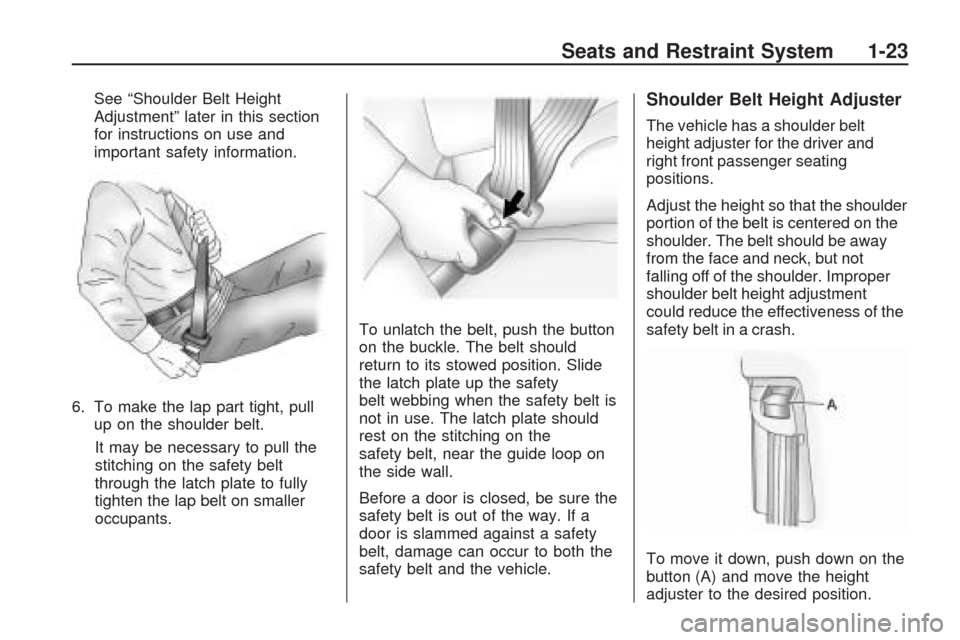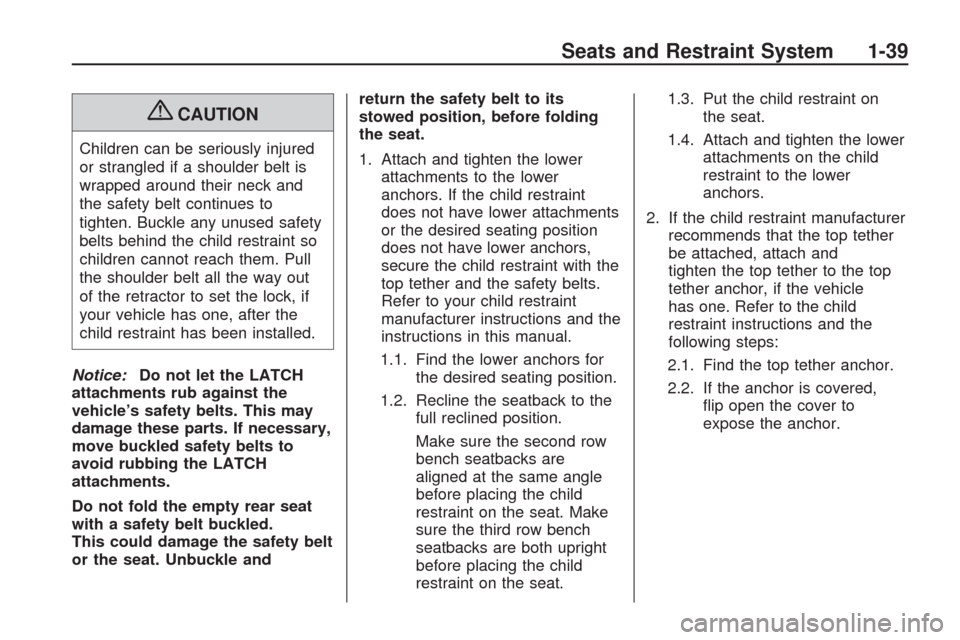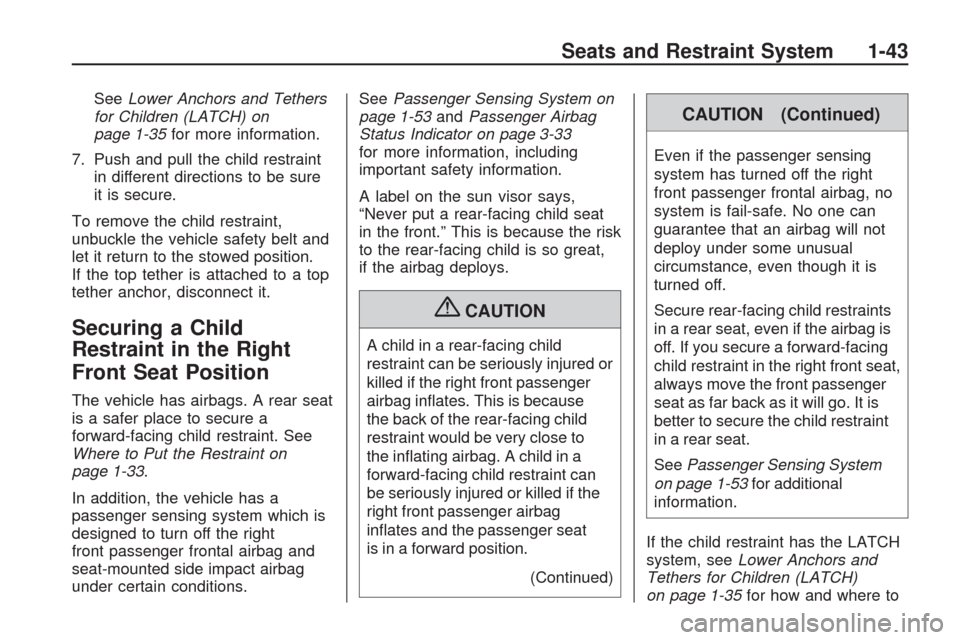2009 CHEVROLET TRAVERSE tow
[x] Cancel search: towPage 1 of 422

Seats and Restraint
System............................... 1-1
Head Restraints
.............. 1-2
Front Seats
.................... 1-3
Rear Seats
.................... 1-9
Safety Belts
..................1-14
Child Restraints
.............1-27
Airbag System
..............1-46
Restraint System
Check
......................1-59
Features and Controls...... 2-1
Keys
............................. 2-2
Doors and Locks
............ 2-8
Windows
......................2-14
Theft-Deterrent
Systems
...................2-16
Starting and Operating
Your Vehicle
.............2-20
Mirrors
.........................2-31
Object Detection
Systems
...................2-36
OnStar
®System
............2-43Universal Home Remote
System
.....................2-47
Storage Areas
...............2-52
Sunroof
........................2-56
Instrument Panel............... 3-1
Instrument Panel
Overview
.................... 3-4
Climate Controls
............3-19
Warning Lights, Gages,
and Indicators
............3-30
Driver Information
Center (DIC)
.............3-44
Audio System(s)
............3-73
Driving Your Vehicle......... 4-1
Your Driving, the Road,
and the Vehicle
........... 4-1
Towing
........................4-21
Service and
Appearance Care............... 5-1
Service
.......................... 5-3
Fuel
.............................. 5-5
Checking Things Under
the Hood
.................... 5-9Headlamp Aiming
..........5-33
Bulb Replacement
.........5-33
Windshield Wiper Blade
Replacement
.............5-35
Tires
...........................5-36
Appearance Care
..........5-78
Vehicle Identi�cation
......5-85
Electrical System
...........5-85
Capacities and
Speci�cations
............5-92
Maintenance Schedule...... 6-1
Maintenance Schedule
..... 6-1
Customer Assistance
Information........................ 7-1
Customer Assistance and
Information
................. 7-1
Reporting Safety
Defects
.....................7-14
Vehicle Data Recording
and Privacy
...............7-16
Index....................................i-1
2009 Chevrolet Traverse Owner ManualM
Page 4 of 422

Vehicle Symbol Chart
Here are some additional symbols
that may be found on the vehicle
and what they mean. For more
information on the symbol, refer to
the index.
9:Airbag Readiness Light
#:Air Conditioning
!:Antilock Brake System (ABS)
g:Audio Steering Wheel
Controls or OnStar®
$:Brake System Warning Light
":Charging System
I:Cruise Control
B:Engine Coolant Temperature
O:Exterior Lamps
#:Fog Lamps
.:Fuel Gage
+:Fuses
i:Headlamp High/Low-Beam
Changer
j:LATCH System Child Restraints
*:Malfunction Indicator Lamp
::Oil Pressure
g:Outside Power Foldaway
Mirrors
}:Power
/:Remote Vehicle Start
>:Safety Belt Reminders
7:Tire Pressure Monitor
_:Tow/Haul Mode
F:Traction Control
M:Windshield Washer Fluid
iv Preface
Page 14 of 422

Entering and Exiting the
Third Row
{CAUTION
Using the third row seating
position while the second row is
folded, or folded and tumbled,
could cause injury in a sudden stop
or crash. Be sure to return the seat
to the passenger seating position.
Push and pull on the seat to make
sure it is locked into place.
Notice:Folding a rear seat with
the safety belts still fastened may
cause damage to the seat or the
safety belts. Always unbuckle the
safety belts and return them to
their normal stowed position
before folding a rear seat.To access the third row:
1. Remove objects on the �oor in
front of or on the second row
seat, or in the seat tracks on
the �oor.
2. Move the front center console
armrest completely forward.
SeeCenter Console Storage on
page 2-52.3. Place folding armrests in the
upright position.
4. Ensure that the safety belt is
unfastened and in the stowed
position.
5. Pull the sliding seat lever (C)
forward and move the seatback
forward. The seat cushion
will fold, and the entire seat will
slide forward.
1-10 Seats and Restraint System
Page 16 of 422

Third Row Seats
{CAUTION
Using the third row seating
position while the second row is
folded, or pushed forward in the
entry position, could cause injury
in a sudden stop or crash. Be
sure to return the seat to the
passenger seating position. Push
and pull on the seat to make sure
it is locked into place.
The third row seats can be folded
forward or removed.
Notice:Folding a rear seat with
the safety belts still fastened may
cause damage to the seat or the
safety belts. Always unbuckle the
safety belts and return them to
their normal stowed position
before folding a rear seat.To fold the seatback:
1. Remove anything on or under
the seat.
2. Disconnect the rear safety belt
mini-latch, using a key in the
slot on the mini-buckle, let
the belt retract into the headliner.
Stow the mini-latch in the
holder located in the headliner.3. Pull up on the release lever
located on the back of the
seat. The headrest moves
forward automatically.
4. Push the seatback forward to
lay �at.
To return the seatback to the
seating position:
1. Raise the seatback into place by
using the pullstrap from the rear
of the vehicle, or by pushing
it into place from inside the
vehicle.
1-12 Seats and Restraint System
Page 17 of 422

2. The headrest must be locked
into place before sitting in
the seat.
{CAUTION
If either seatback is not locked, it
could move forward in a sudden
stop or crash. That could cause
injury to the person sitting there.
Always push and pull on the
seatbacks to be sure they are
locked.
3. Push and pull on the seatback to
make sure it is locked in place.
{CAUTION
A safety belt that is improperly
routed, not properly attached,
or twisted will not provide the
protection needed in a crash. The
person wearing the belt could be
seriously injured. After raising the
(Continued)
CAUTION (Continued)
rear seatback, always check to be
sure that the safety belts are
properly routed and attached, and
are not twisted.
4. Reconnect the center safety belt
mini-latch to the mini-buckle.
Do not let it twist.
5. Pull on the safety belt to be sure
the mini-latch is secure.
Removing the Third
Row Seats
1. Remove the cargo management
system, if it is in the vehicle.
SeeCargo Management System
on page 2-55.
2. Remove anything on or under
the seat.
Notice:Folding a rear seat with
the safety belts still fastened may
cause damage to the seat or the
safety belts. Always unbuckle thesafety belts and return them to
their normal stowed position
before folding a rear seat.
3. Fold the seatback down. See
“Folding the Seatback” earlier
in this section.
4. Remove the rear bolts located on
the �oor on each side of the seat.
5. Remove the seat by tilting it
slightly upward, and then
pulling it out of the rear of
the vehicle in one motion.
6. Replace the bolts in the �oor
holes for storage.Installing the Third Row Seats
1. Before installing the seat the
seatback must be folded forward.
See “Folding the Seatback”
earlier in this section.
The seats must be placed in the
proper locations to attach
correctly. The wider seat must be
installed on the driver side and
the narrower seat on the
passenger side.
Seats and Restraint System 1-13
Page 27 of 422

See “Shoulder Belt Height
Adjustment” later in this section
for instructions on use and
important safety information.
6. To make the lap part tight, pull
up on the shoulder belt.
It may be necessary to pull the
stitching on the safety belt
through the latch plate to fully
tighten the lap belt on smaller
occupants.To unlatch the belt, push the button
on the buckle. The belt should
return to its stowed position. Slide
the latch plate up the safety
belt webbing when the safety belt is
not in use. The latch plate should
rest on the stitching on the
safety belt, near the guide loop on
the side wall.
Before a door is closed, be sure the
safety belt is out of the way. If a
door is slammed against a safety
belt, damage can occur to both the
safety belt and the vehicle.Shoulder Belt Height Adjuster
The vehicle has a shoulder belt
height adjuster for the driver and
right front passenger seating
positions.
Adjust the height so that the shoulder
portion of the belt is centered on the
shoulder. The belt should be away
from the face and neck, but not
falling off of the shoulder. Improper
shoulder belt height adjustment
could reduce the effectiveness of the
safety belt in a crash.
To move it down, push down on the
button (A) and move the height
adjuster to the desired position.
Seats and Restraint System 1-23
Page 43 of 422

{CAUTION
Children can be seriously injured
or strangled if a shoulder belt is
wrapped around their neck and
the safety belt continues to
tighten. Buckle any unused safety
belts behind the child restraint so
children cannot reach them. Pull
the shoulder belt all the way out
of the retractor to set the lock, if
your vehicle has one, after the
child restraint has been installed.
Notice:Do not let the LATCH
attachments rub against the
vehicle’s safety belts. This may
damage these parts. If necessary,
move buckled safety belts to
avoid rubbing the LATCH
attachments.
Do not fold the empty rear seat
with a safety belt buckled.
This could damage the safety belt
or the seat. Unbuckle andreturn the safety belt to its
stowed position, before folding
the seat.
1. Attach and tighten the lower
attachments to the lower
anchors. If the child restraint
does not have lower attachments
or the desired seating position
does not have lower anchors,
secure the child restraint with the
top tether and the safety belts.
Refer to your child restraint
manufacturer instructions and the
instructions in this manual.
1.1. Find the lower anchors for
the desired seating position.
1.2. Recline the seatback to the
full reclined position.
Make sure the second row
bench seatbacks are
aligned at the same angle
before placing the child
restraint on the seat. Make
sure the third row bench
seatbacks are both upright
before placing the child
restraint on the seat.1.3. Put the child restraint on
the seat.
1.4. Attach and tighten the lower
attachments on the child
restraint to the lower
anchors.
2. If the child restraint manufacturer
recommends that the top tether
be attached, attach and
tighten the top tether to the top
tether anchor, if the vehicle
has one. Refer to the child
restraint instructions and the
following steps:
2.1. Find the top tether anchor.
2.2. If the anchor is covered,
�ip open the cover to
expose the anchor.
Seats and Restraint System 1-39
Page 47 of 422

SeeLower Anchors and Tethers
for Children (LATCH) on
page 1-35for more information.
7. Push and pull the child restraint
in different directions to be sure
it is secure.
To remove the child restraint,
unbuckle the vehicle safety belt and
let it return to the stowed position.
If the top tether is attached to a top
tether anchor, disconnect it.
Securing a Child
Restraint in the Right
Front Seat Position
The vehicle has airbags. A rear seat
is a safer place to secure a
forward-facing child restraint. See
Where to Put the Restraint on
page 1-33.
In addition, the vehicle has a
passenger sensing system which is
designed to turn off the right
front passenger frontal airbag and
seat-mounted side impact airbag
under certain conditions.SeePassenger Sensing System on
page 1-53andPassenger Airbag
Status Indicator on page 3-33
for more information, including
important safety information.
A label on the sun visor says,
“Never put a rear-facing child seat
in the front.” This is because the risk
to the rear-facing child is so great,
if the airbag deploys.
{CAUTION
A child in a rear-facing child
restraint can be seriously injured or
killed if the right front passenger
airbag in�ates. This is because
the back of the rear-facing child
restraint would be very close to
the in�ating airbag. A child in a
forward-facing child restraint can
be seriously injured or killed if the
right front passenger airbag
in�ates and the passenger seat
is in a forward position.
(Continued)
CAUTION (Continued)
Even if the passenger sensing
system has turned off the right
front passenger frontal airbag, no
system is fail-safe. No one can
guarantee that an airbag will not
deploy under some unusual
circumstance, even though it is
turned off.
Secure rear-facing child restraints
in a rear seat, even if the airbag is
off. If you secure a forward-facing
child restraint in the right front seat,
always move the front passenger
seat as far back as it will go. It is
better to secure the child restraint
in a rear seat.
SeePassenger Sensing System
on page 1-53for additional
information.
If the child restraint has the LATCH
system, seeLower Anchors and
Tethers for Children (LATCH)
on page 1-35for how and where to
Seats and Restraint System 1-43